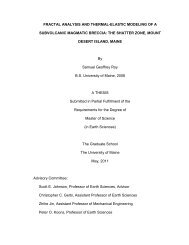Latis II Underwater Remotely Operated Vehicle Technical Report
Latis II Underwater Remotely Operated Vehicle Technical Report
Latis II Underwater Remotely Operated Vehicle Technical Report
You also want an ePaper? Increase the reach of your titles
YUMPU automatically turns print PDFs into web optimized ePapers that Google loves.
DESIGN RATIONALE<br />
MISSIONS<br />
After establishing that the UMaine ROV team<br />
could successfully build, program and operate<br />
the prototype, <strong>Latis</strong> I, the team began the<br />
design process to create a new ROV specifically<br />
designed for the MATE ROV Competition. The<br />
team focused on compactness, efficiency,<br />
simplicity, and manufacturability in the final<br />
design. The following is a short description of<br />
the design rationale followed for each task<br />
appointed by MATE.<br />
11<br />
Figure 12: Prototype ROV, <strong>Latis</strong> I<br />
TASK #1 – RESURRECT HUGO<br />
The first mission requires the ROV to locate an<br />
area of seismic activity, release the High Rate<br />
Hyrdophone (HRH) from the elevator, and<br />
install it at that spot. Next, the ROV must open<br />
the port on HUGO’s junction box and insert the<br />
HRH’s cable. To accomplish these tasks, <strong>Latis</strong> <strong>II</strong><br />
has a hydrophone installed on the front of the<br />
body which can detect sound waves. The<br />
LabVIEW dashboard provides a graphical display<br />
of the sound waves underwater and gives a<br />
numeric value of the frequency. The ROV also<br />
has opposing four degree-of-freedom arms<br />
outfitted with grippers. This will allow the ROV<br />
to remove both pins from the HRH<br />
simultaneously and move it to the location<br />
LATIS <strong>II</strong><br />
TECHNICAL REPORT<br />
emitting the sound waves on the pool floor.<br />
<strong>Latis</strong> <strong>II</strong> has three cameras installed to give the<br />
operators multiple views of the arms and any<br />
objects the ROV needs to grab or manipulate.<br />
These multiple viewing angles allow the<br />
operator to successfully complete this task. The<br />
grippers were designed specifically to hold the<br />
elevator and HRH frame so that the ROV is<br />
stable as it removes the HRH.<br />
TASK #2 – COLLECTING CRUSTACEANS<br />
The mission involves entering an 80cm by 80cm<br />
cave, collecting crustaceans, and returning<br />
them to the surface. It is with this task in mind<br />
that the ROV Team designed such dexterous<br />
arms. The increased flexibility of the arms<br />
allows them to be particularly useful in this task<br />
as the ROV will only have to rest on the bottom<br />
of the pool as the arms do the work. Two LED<br />
lights installed on the front of the ROV allows<br />
the operator to clearly see the inside the cave.<br />
A retractable net affixed to the front of the<br />
skids makes a handy place for storing<br />
crustaceans that will be brought to the surface.<br />
Having the net on the front of the ROV provides<br />
storage space for the crustaceans so that no<br />
time has to be wasted returning to the surface<br />
to retrieve them. The overall size of the ROV<br />
was decided when designing for this task as it is<br />
the only one with a size limit. The dimensions of<br />
the ROV are 43cm wide, 60cm long and 29cm<br />
tall. This allows the ROV to maneuver freely<br />
through the cave.

















